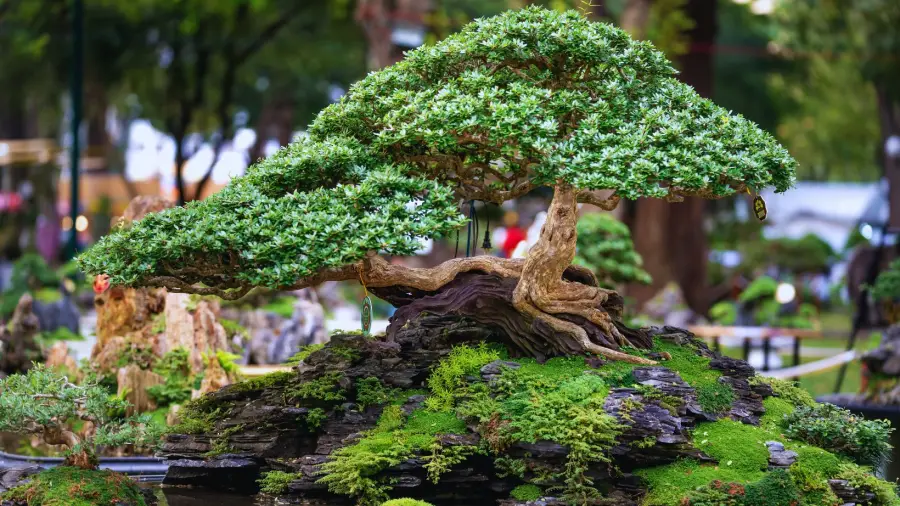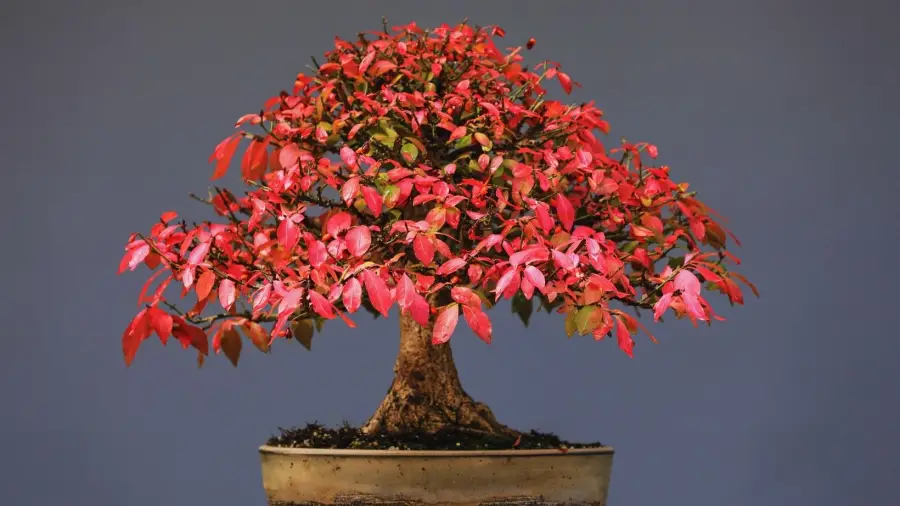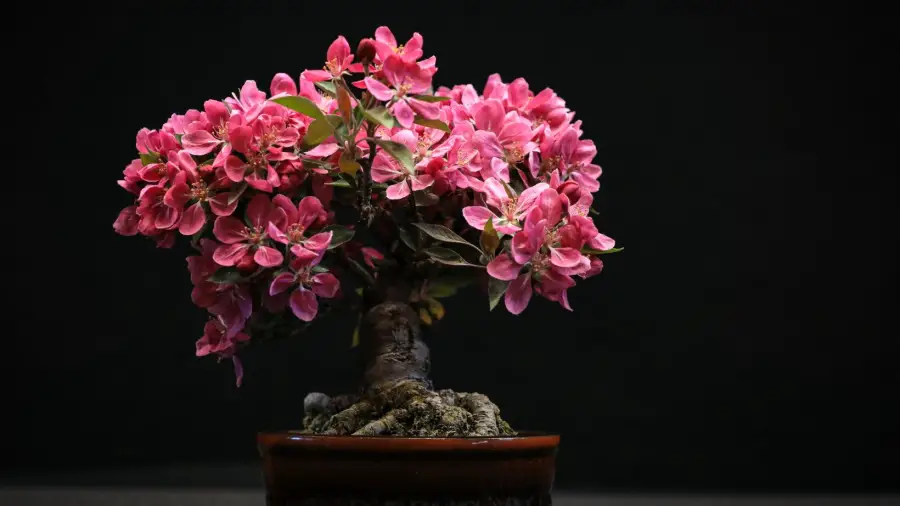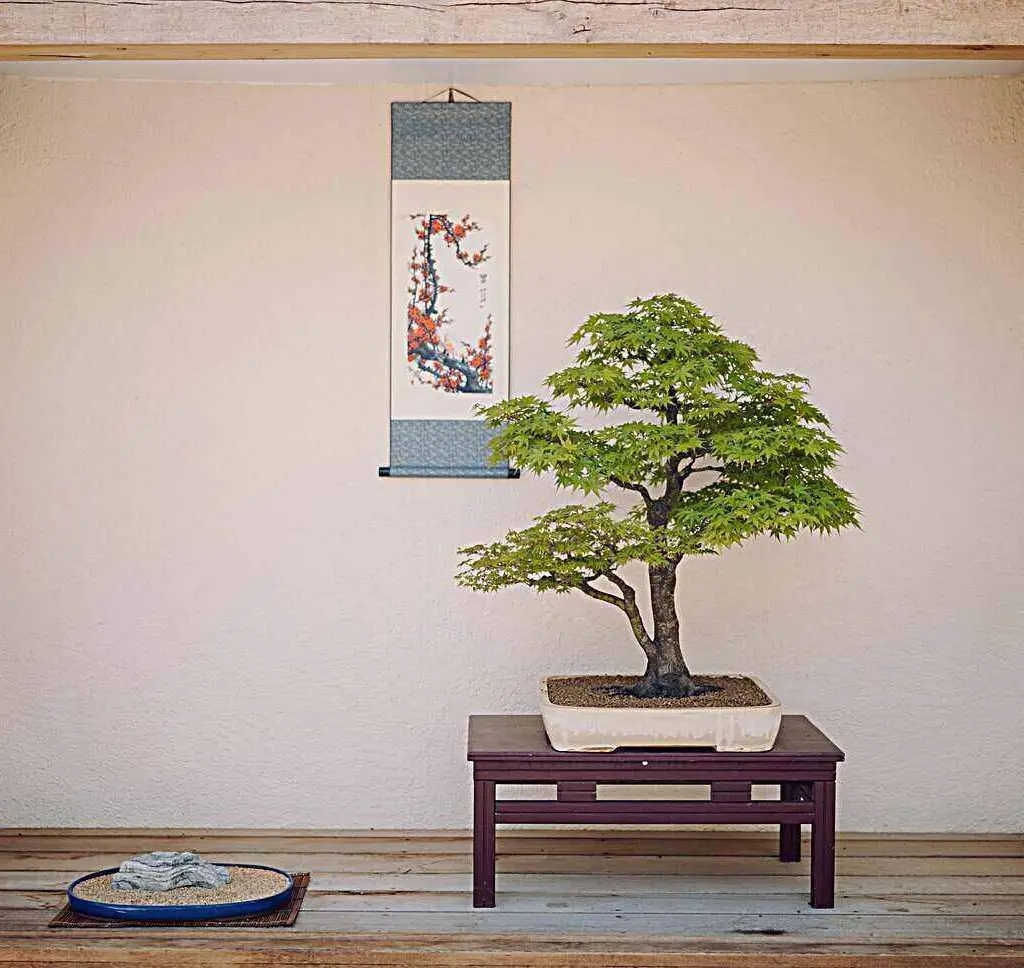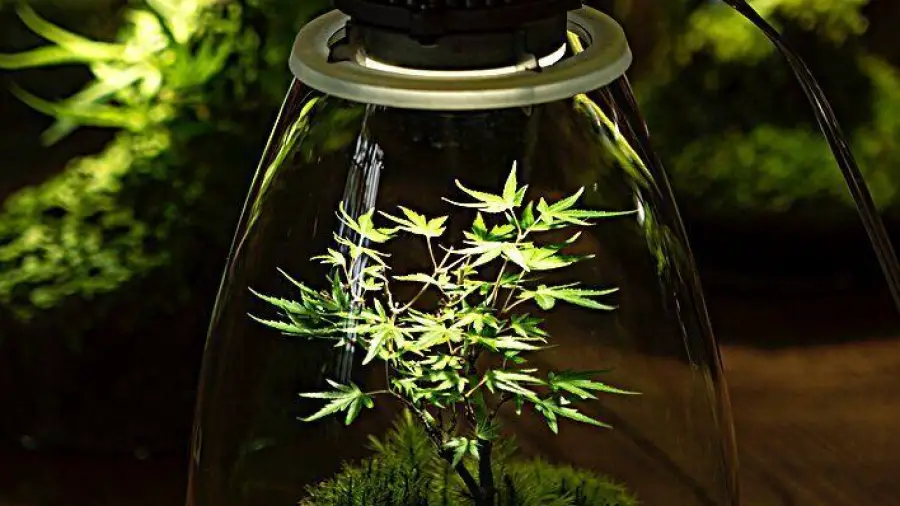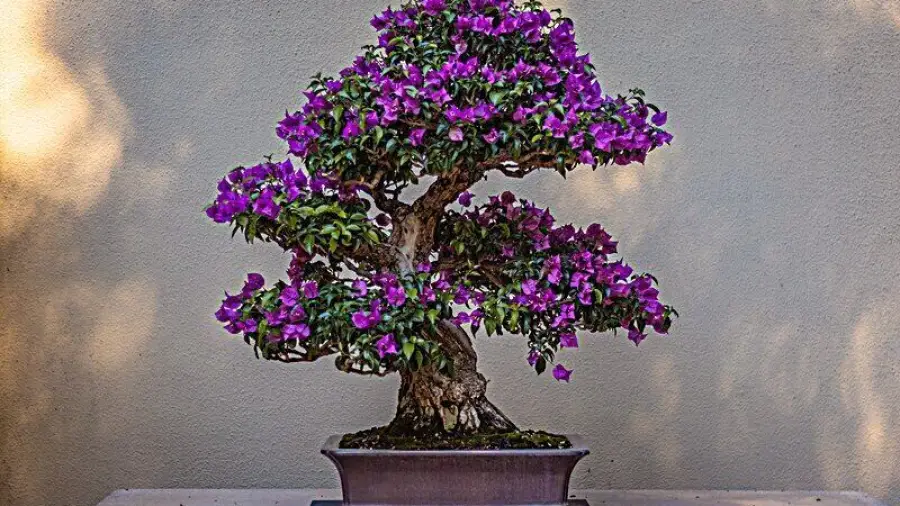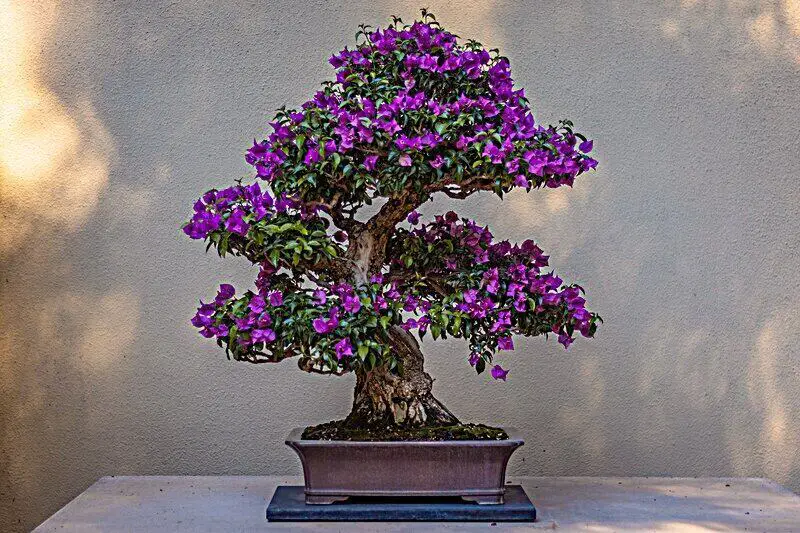Bonsai plants are made by growing small trees from regular stock and seeds, using cultivation techniques like pruning, root reduction, potting, defoliation, and grafting to mimic the shape and style of mature trees. Bonsai is an art form that involves carefully shaping and caring for miniature trees in pots.
Unlike popular belief, bonsai is not created from genetically-dwarfed trees. Instead, regular stock and seeds are used, and various cultivation techniques are employed to keep the trees small and mimic the appearance of mature, full-size trees. These techniques include pruning, root reduction, potting, defoliation, and grafting.
The process of creating a bonsai tree requires skill, patience, and the right tools. However, with the proper knowledge and techniques, anyone can learn to make and maintain these beautiful miniature trees.

Choosing The Right Source Material Tree
When it comes to creating bonsai plants, selecting the right source material tree is a crucial step. Bonsai does not require genetically-dwarfed trees; instead, it relies on cultivating small trees from regular stock and seeds. By using various techniques such as pruning, root reduction, potting, defoliation, and grafting, bonsai artists are able to transform these trees into miniature versions that mimic the shape and style of mature, full-sized trees.
Selecting Trees Suitable For Bonsai Cultivation
Not all trees are suitable for bonsai cultivation. When selecting a source material tree, there are a few factors to consider:
- Tree species and characteristics: Different tree species have varying characteristics that make them more suitable or less suitable for bonsai. Some species that are commonly chosen for bonsai include pine, maple, juniper, and ficus. These trees have desirable traits such as small leaves, interesting bark, and flexible branches that are well-suited for bonsai cultivation.
- Overall health: It is important to choose a source material tree that is healthy and free from any major diseases or issues. A tree with a strong and vigorous growth pattern will have a higher chance of survival and successful bonsai development.
- Size and age: When selecting a tree for bonsai, it is essential to consider its size and age. Younger, smaller trees are often preferred as they are more flexible and easier to manipulate. Additionally, smaller trees tend to have more proportional features, which is desirable in bonsai aesthetics.
Evaluation Of Trunk Shape And Size
The trunk of a bonsai tree plays a significant role in its overall aesthetic appeal. When evaluating the trunk shape and size of a potential source material tree, there are several factors to keep in mind:
- Trunk movement: The trunk of a bonsai tree should have natural movement and curves, mimicking the shapes found in mature trees. Straight trunks are generally avoided in bonsai as they lack visual interest and can appear rigid.
- Trunk thickness: The thickness of the trunk is another important consideration. Bonsai artists aim for a trunk that is proportional to the overall size of the tree. Too thick or too thin trunks can create an imbalance in the overall bonsai composition.
- Nebari (root spread): The root spread, known as nebari, is also evaluated when selecting a source material tree. Ideally, the roots should radiate evenly from the base of the trunk, creating a well-balanced and stable foundation for the bonsai.
By carefully considering these factors when choosing the right source material tree for bonsai cultivation, bonsai enthusiasts can ensure a solid foundation for their artistic creations.
Training Techniques For Bonsai Creation
Bonsai creation is an intricate art form that requires a combination of specialized training techniques. These techniques are used to shape and maintain the form of the tree, control growth, and introduce new features and styles. The training techniques for bonsai creation include pruning techniques for shaping and maintaining the tree’s form, root reduction and potting methods for controlling growth, defoliation and leaf trimming techniques for size control, and grafting techniques for introducing new features and styles.
Pruning Techniques For Shaping And Maintaining The Tree’s Form
Pruning is a crucial technique used in bonsai creation to shape and maintain the form of the tree. By selectively removing branches, the bonsai artist can sculpt the tree’s shape and create the desired aesthetic. Pruning also helps in maintaining the size and proportions of the tree, ensuring it remains in miniature form. Regular pruning is necessary to prevent overcrowding and to promote healthy growth. Pruning is often done in early spring or late fall when the tree is dormant to minimize stress on the plant.
Root Reduction And Potting Methods For Controlling Growth
Root reduction and potting methods are essential for controlling the growth of bonsai trees. By periodically repotting the tree and trimming the roots, the bonsai artist can restrict the growth and encourage a compact root system. This process helps maintain the small size of the tree and prevents it from becoming too vigorous. Typically, the bonsai tree is repotted every two to three years, allowing for root pruning and repositioning of the plant in a shallow bonsai pot. The use of well-draining soil is also critical for healthy root growth and overall tree development.
Defoliation And Leaf Trimming Techniques For Size Control
To control the size of the bonsai tree, defoliation and leaf trimming techniques are employed. Defoliation involves removing the leaves of the tree, which stimulates new growth and helps in reducing leaf size. This technique is generally done during the tree’s active growing season and should be followed by proper care and maintenance to ensure the tree’s health. Leaf trimming, on the other hand, involves selectively pruning the leaves to maintain the desired aesthetic and size of the bonsai. Regular leaf trimming helps in shaping the tree and maintaining its miniature appearance.
Grafting Techniques For Introducing New Features And Styles
Grafting is a technique used in bonsai creation to introduce new features and styles to the tree. It involves joining a branch or section of one tree (the scion) to another tree (the rootstock) to create a desired effect. This technique allows bonsai artists to incorporate new branches, foliage, or flowering characteristics into the bonsai tree, enhancing its beauty and unique style. Grafting requires skill and precision, as it involves matching the cambium layers of the scion and rootstock to ensure successful union and growth.
Overall, these training techniques play a vital role in the creation and development of bonsai plants. Through proper pruning, root reduction, defoliation, and grafting, bonsai artists can shape and maintain the aesthetic appeal of these miniature trees. It is the careful application of these techniques that allows bonsai plants to mimic the shape and style of mature, full-size trees while remaining in a smaller, compact form.
Step-by-step Process For Creating A Bonsai Tree
Bonsai plants are made by growing small trees from regular stock and seeds, using techniques like pruning, root reduction, potting, defoliation, and grafting to mimic the shape and style of mature trees. This art form requires the right skills and tools to create a miniature tree that is both unique and beautiful.
Step 1: Preparing The Tree For Bonsai Creation
To begin the process of creating a bonsai tree, it is important to select a suitable tree. While bonsai can be made from various tree species, it is recommended to choose a tree that is hardy and adaptable to your climate. Once selected, the tree is prepared for bonsai creation by assessing its overall health and shape. Dead branches and excess foliage are removed to ensure the tree’s vitality and to create an aesthetically pleasing form.
Step 2: Soil Selection And Preparation
Soil selection is crucial for the successful growth of a bonsai tree. Bonsai trees require well-draining soil to prevent waterlogging and root rot. A mixture of organic and inorganic materials, such as akadama clay, pumice, and compost, is commonly used. The soil mixture should provide adequate nutrition, water retention, and aeration for the tree’s roots. Before potting the tree, the soil mixture is prepared by sieving it to remove any debris and ensure a fine texture that allows for proper root growth.
Step 3: Choosing The Right Pot Or Container
The choice of pot or container for a bonsai tree is not merely for aesthetic purposes but also for functionality. The pot should be suitable in size, shape, and style to complement the tree’s form and enhance its overall appearance. Additionally, the pot should have drainage holes to allow excess water to escape, preventing waterlogging. Porous materials such as ceramic or clay are commonly used for bonsai pots as they facilitate proper airflow and water regulation.
Step 4: Pruning And Shaping The Tree’s Branches And Foliage
Pruning plays a crucial role in bonsai creation as it helps manage the size and shape of the tree. During this step, the branches and foliage are carefully pruned to remove any unwanted growth and achieve the desired shape. Proper pruning techniques, such as branch selection, directional pruning, and defoliation, are implemented to create an aesthetically pleasing and balanced structure. Pruning also encourages new growth and helps maintain the miniature size of the tree.
Step 5: Techniques For Creating A Desired Silhouette
Creating a desired silhouette is one of the defining aspects of bonsai artistry. Various techniques, such as wiring and bending branches, are used to shape the tree and achieve the desired form. With careful manipulation, the bonsai artist can create elegant curves, dynamic movements, and an overall balanced silhouette. Wiring is done using special bonsai wire, which is wrapped around branches and gently bent to guide their growth and achieve the desired shape.
Step 6: Considerations For Branch Placement And Balance
The placement of branches in a bonsai tree is crucial for creating a natural and harmonious composition. Careful consideration is given to the balance and positioning of branches to reflect the tree’s growth pattern in nature. Branches are arranged in a graduated manner, with thick branches at the bottom and progressively thinner branches as we move upwards. This technique, known as tapering, helps create the illusion of maturity and stability in the bonsai tree.
Step 7: Root Reduction And Potting Process
Root reduction is a vital step in bonsai creation as it allows the tree to be suitable for pot cultivation and restricted growth. During this process, excess roots are carefully pruned, and the remaining roots are trimmed to fit the bonsai pot. The root reduction helps create a compact root system that will fit within the limited space of the pot while promoting healthy root growth and nutrient absorption.
Step 8: Proper Root Trimming And Grooming
After root reduction, the remaining roots are meticulously trimmed and groomed to further enhance their structure and promote a healthy root system. Dead or damaged roots are removed, and long, straggling roots are pruned to encourage the growth of finer feeder roots. Grooming the roots ensures proper nutrient uptake, water absorption, and overall health of the bonsai tree.
Step 9: Selecting The Appropriate Potting Soil Mixture
After root trimming and grooming, the bonsai tree is ready to be potted. The appropriate potting soil mixture, prepared earlier, is carefully placed in the pot, ensuring that the roots are adequately covered. The soil is gently pressed around the roots to provide stability while allowing for proper aeration and drainage. Excess soil is removed, and the tree’s position within the pot is adjusted to achieve an appealing composition.
Step 10: Care And Maintenance After Potting
Once the bonsai tree is potted, proper care and maintenance are essential to ensure its health and longevity. This includes watering the tree regularly, providing appropriate sunlight exposure, and maintaining optimal humidity levels. Additionally, fertilization is necessary to provide the tree with essential nutrients for growth and vitality. Regular monitoring and pruning of branches and foliage are also essential to maintain the tree’s desired shape and form.
Note: Care should be taken to avoid overwatering or underwatering the bonsai tree, as these can lead to root rot or dehydration. Adequate sunlight and temperature requirements specific to the tree’s species should be met to support healthy growth and overall well-being.
Tips And Tricks For Successful Bonsai Creation
Bonsai plants are made through cultivation techniques such as pruning, root reduction, potting, defoliation, and grafting. Unlike genetically-dwarfed trees, Bonsai relies on growing small trees from regular stock and seeds to mimic the shape and style of mature, full-size trees.
With the right skills and tools, anyone can create a Bonsai tree from a normal tree, turning it into a beautiful work of art.
Choosing The Right Tools And Equipment:
To create a beautiful bonsai tree, it’s important to have the right tools and equipment. Here are some essentials you’ll need:
- Bonsai pruning shears: These specialized shears are designed to make precise cuts on small branches and foliage. They come in different sizes, so choose one that suits the thickness of the branches you’ll be working with.
- Bonsai wire: This flexible wire is used to shape the branches and trunks of your bonsai tree. It’s important to choose the right gauge for your tree, as thinner wire is suitable for smaller branches and thicker wire for larger ones.
- Bonsai pot: The pot you choose should be shallow and have drainage holes to prevent waterlogging. It’s also important to choose a pot that complements the style and size of your bonsai tree.
- Bonsai soil: Bonsai trees require well-draining soil to ensure healthy growth. You can either purchase bonsai soil or create your own mix by combining ingredients like akadama, pumice, and lava rock.
Understanding The Needs Of Different Tree Species:
Each tree species has unique requirements when it comes to light, moisture, and temperature. Understanding these needs is crucial for the success of your bonsai creation. Here are some examples:
| Tree Species | Light | Watering | Temperature |
|---|---|---|---|
| Juniper | Full sun to partial shade | Allow the soil to dry slightly between waterings | Hardy and can tolerate a wide range of temperatures |
| Maple | Partial shade to full sun | Keep the soil consistently moist but not waterlogged | Prefers cool to moderate temperatures |
| Pine | Full sun | Water deeply when the top inch of soil feels dry | Tolerates both cold and warm temperatures |
Regular Care Routines And Monitoring For Growth:
To ensure the health and growth of your bonsai tree, it’s important to establish a regular care routine. Here are some tips:
- Watering: Check the moisture level of the soil regularly and water accordingly. Avoid overwatering, as it can lead to root rot.
- Pruning: Regularly prune your bonsai tree to maintain its shape and encourage new growth. Remove any dead, damaged, or crossing branches to maintain a clean and balanced appearance.
- Fertilizing: Bonsai trees require regular fertilization to ensure optimal growth. Use a balanced bonsai fertilizer and follow the manufacturer’s instructions for application.
- Monitoring for pests and diseases: Regularly inspect your bonsai tree for any signs of pests or diseases. Treat any issues promptly to prevent them from spreading and causing damage to your tree.
Troubleshooting Common Issues And Challenges:
Despite your best efforts, you may encounter some common issues and challenges while creating and maintaining your bonsai tree. Here are some troubleshooting tips:
- Yellowing leaves: This can be a sign of overwatering or underwatering. Adjust your watering routine accordingly and ensure proper drainage.
- Poor growth: If your bonsai tree is not growing as expected, it may need more light or better nutrition. Consider adjusting its positioning and fertilization routine.
- Root rot: Overwatering or poor drainage can lead to root rot. If you notice soft and mushy roots, repot your bonsai tree in fresh, well-draining soil.
- Pest infestation: Common pests that can affect bonsai trees include aphids, scale insects, and spider mites. Use organic pest control methods or consult with a professional for effective solutions.
By following these tips and tricks for successful bonsai creation, you can create and maintain healthy and beautiful bonsai trees that will bring you joy for years to come. Remember, patience and attention to detail are key when it comes to the art of bonsai. Happy cultivating!
Frequently Asked Questions On How Bonsai Plants Are Made
Can I Make A Bonsai From Any Tree?
Yes, any tree can be transformed into a bonsai using techniques like pruning, root reduction, potting, defoliation, and grafting. Bonsai does not require genetically-dwarfed trees but rather focuses on cultivating small trees that mimic the shape and style of mature trees.
Do Bonsai Occur Naturally?
Bonsai does not occur naturally. It is an art form that involves cultivating small trees using techniques like pruning, root reduction, and grafting. Bonsai trees are created from regular stock and seeds, and they mimic the shape and style of mature, full-size trees.
How Many Years Does It Take To Make A Bonsai Tree?
Bonsai trees take several years to grow. The process involves techniques like pruning, root reduction, potting, defoliation, and grafting to mimic the shape and style of mature trees. The time frame varies depending on the species and desired size of the bonsai tree.
Can You Grow A Bonsai From Scratch?
Yes, you can grow a bonsai from scratch by using regular stock and seeds, and applying techniques such as pruning, root reduction, potting, defoliation, and grafting. Growing bonsai from tree seeds is a rewarding but patience-demanding process.
Conclusion
In the fascinating world of bonsai plants, creating these miniature wonders is an art that requires special techniques. Instead of genetically-dwarfed trees, bonsai cultivators rely on various methods such as pruning, root reduction, potting, defoliation, and grafting to craft small trees that closely resemble their mature counterparts.
With the right skills and tools, anyone can turn a regular tree into a bonsai masterpiece. Remember, bonsai is more than just a plant in a pot; it is a timeless expression of artistry and dedication. So, unleash your creativity and nurture your own unique bonsai tree.
